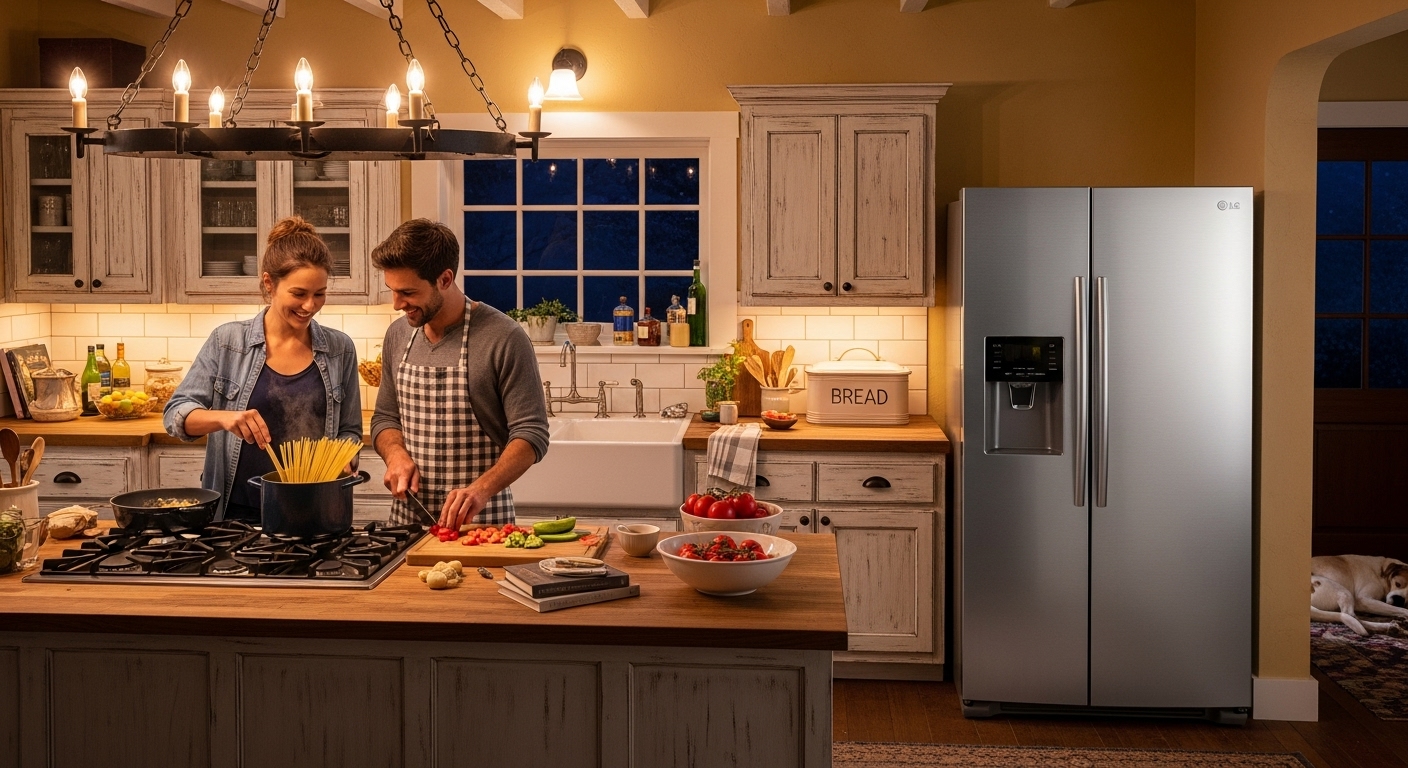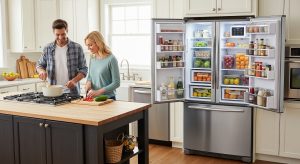Your Essential Maintenance Guide
While most refrigerator owners are familiar with water filters, many overlook another critical component: the air filter. LG refrigerators equipped with air filtration systems use these specialized filters to keep your food fresher longer by removing odors and bacteria from the refrigerator’s interior. Understanding how to maintain and replace your air filter is an important part of refrigerator care.
The Purpose of Refrigerator Air Filters
LG’s air filters serve a different purpose than water filters. These filters work to purify the air circulating inside your refrigerator compartment, eliminating food odors, ethylene gas (which accelerates ripening), and airborne bacteria. The result is fresher-smelling food, reduced cross-contamination of flavors, and extended shelf life for produce and other perishables.
Many LG refrigerators feature the Fresh Air Filter system, which uses activated carbon and other filtration media to continuously clean the air. This technology is particularly beneficial if you store strong-smelling foods like onions, garlic, or fish, or if you want to keep fruits and vegetables fresh for longer periods.
When to Replace Your Air Filter
Unlike water filters that typically last six months, LG air filters generally need replacement every six months as well, though this can vary by model. The replacement schedule depends on several factors including how frequently you open the refrigerator, what types of foods you store, and your specific LG model.
Indicators that it’s time for a new air filter:
- Persistent odors in the refrigerator even after cleaning
- Food seems to spoil more quickly than usual
- Strong food smells transfer between items
- The filter replacement indicator light activates (on models equipped with this feature)
- Six months have passed since your last replacement
- Visible discoloration or buildup on the filter
Identifying Your LG Air Filter Model
LG uses different air filter models depending on the refrigerator series. The most common air filter models include the LT120F and ADQ73214404. Some newer LG models don’t require air filters at all, instead using built-in deodorizing systems that don’t need replacement.
To determine if your refrigerator has a replaceable air filter, check your owner’s manual or look inside the refrigerator compartment for a small, vented filter housing. This is typically located on the back wall of the fresh food compartment, near the top. If you’re unsure, you can also look up your refrigerator’s model number on LG’s website to see the compatible parts.
Locating the Air Filter
The location of the air filter varies depending on your LG refrigerator model, but there are several common placements. Most frequently, you’ll find the air filter on the back wall of the fresh food section, positioned near the top shelf. It’s housed behind a small cover or grille that’s usually white or matches your refrigerator’s interior.
Some French door models place the air filter on the ceiling of the refrigerator compartment, while certain side-by-side models position it near the ice maker area. Look for a small rectangular or circular cover with ventilation slots—this typically marks the filter location.
Step-by-Step Replacement Instructions
Replacing an LG refrigerator air filter is one of the simplest maintenance tasks you can perform. No tools are required, and the process takes just a minute or two.
Removing the old filter:
First, locate the air filter cover inside your refrigerator. You’ll notice it has a release mechanism—either a button, tab, or twist-lock design. For push-button models, press the release button and gently pull the cover forward to remove it. For twist-lock models, turn the cover counterclockwise about a quarter turn, then pull it out.
Once the cover is open, you’ll see the air filter cartridge inside. Simply pull the old filter straight out of its housing. There’s no need to worry about water spillage as with water filters—air filters are completely dry.
Installing the new filter:
Remove the new air filter from its packaging. Some filters come with protective plastic wrapping that must be removed before installation. Check carefully to ensure all packaging materials are removed, as leaving plastic on can prevent proper air flow.
Insert the new filter into the housing, making sure it’s oriented correctly. Most filters have an arrow or label indicating which way they should face. Push the filter firmly into place until it’s fully seated in the housing.
Replace the filter cover by aligning it with the housing and either pushing it until it clicks into place or turning it clockwise to lock it. The cover should sit flush against the refrigerator wall.
Resetting the Filter Indicator
If your LG refrigerator has an air filter replacement indicator, you’ll need to reset it after installing a new filter. The reset process varies by model, but generally involves one of these methods:
Press and hold the “Air Filter Reset” button (often located on the control panel) for approximately three seconds until the indicator light changes or you hear a beep. On some models, you may need to press and hold the “Fresh Air Filter” and “Water Filter” buttons simultaneously for three seconds. On touch-screen models, navigate to the filter menu and select “Reset Air Filter.”
Consult your specific model’s user manual if you’re unsure of the exact reset procedure, as it can vary significantly between LG refrigerator lines.
Genuine vs. Compatible Air Filters
When purchasing replacement air filters, you’ll find both genuine LG filters and third-party alternatives. Genuine LG air filters are specifically engineered for LG refrigerators and are guaranteed to fit correctly and perform as designed. They typically cost between $15 and $30, making them more affordable than water filters.
Compatible filters from reputable manufacturers can offer cost savings, sometimes costing 30 to 50 percent less than OEM filters. If you choose this route, verify that the filter is designed for your specific LG model and that it uses quality filtration media like activated carbon. Read customer reviews to ensure the compatible filter performs adequately.
One advantage of genuine LG filters is that they maintain your warranty coverage and are guaranteed to work with your refrigerator’s filter monitoring system.
The Impact of Neglecting Air Filter Replacement
While forgetting to replace your air filter won’t cause immediate damage to your refrigerator, it can affect food quality and your overall kitchen experience. An old, saturated air filter loses its ability to neutralize odors, meaning your refrigerator may develop persistent unpleasant smells that transfer between foods.
Additionally, as the filter becomes clogged, it may restrict air circulation within the refrigerator. This can lead to uneven cooling, temperature inconsistencies, and potentially higher energy consumption as your refrigerator works harder to maintain proper temperatures.
Perhaps most importantly, a depleted air filter can’t effectively remove ethylene gas, which causes fruits and vegetables to ripen and spoil more quickly. This means more food waste and more frequent grocery trips.
Maintenance Tips for Optimal Air Quality
Between filter replacements, you can take several steps to maintain optimal air quality in your refrigerator. Clean your refrigerator interior regularly, wiping down shelves and drawers with mild soap and water to prevent odor buildup. Store strong-smelling foods in airtight containers to reduce the burden on your air filter.
Check expiration dates frequently and remove spoiled food immediately—one forgotten item can create persistent odors. Avoid overcrowding your refrigerator, as this restricts air circulation and makes your air filter work harder.
Consider placing an open box of baking soda on a shelf as an additional odor absorber between filter changes. While this doesn’t replace the air filter’s function, it can help maintain freshness.
Models Without Replaceable Air Filters
It’s worth noting that not all LG refrigerators have replaceable air filters. Some newer models use permanent deodorizing systems that don’t require filter changes. These systems typically use a photocatalytic deodorizer or other technology that regenerates automatically and lasts the lifetime of the refrigerator.
If you don’t find an air filter housing in your refrigerator, check your manual to see if your model has a permanent system. These refrigerators still benefit from regular cleaning, but you won’t need to purchase replacement filters.
Where to Purchase Replacement Filters
LG air filters are widely available from multiple sources. You can purchase them directly from LG’s website, from major appliance retailers, or from online marketplaces like Amazon. Home improvement stores and appliance parts suppliers also typically stock common LG filter models.
When ordering online, always verify that you’re purchasing the correct filter model for your specific refrigerator. Double-check the model number against your owner’s manual or the label inside your refrigerator to avoid ordering the wrong filter.
Maximizing Your Investment
To get the most value from your air filter replacement, mark your calendar or set a smartphone reminder for six months after installation. This helps you stay on schedule and ensures you don’t let the filter go too long without replacement.
Keep spare filters on hand so you’re never caught without a replacement when it’s time to change. Buying filters in multi-packs often provides cost savings compared to purchasing them individually.
The Bottom Line
Replacing your LG refrigerator’s air filter is a quick, inexpensive maintenance task that pays dividends in food freshness and odor control. With replacements needed only twice a year and filters costing $15 to $30, it’s a small investment for significantly improved refrigerator performance. By staying on top of this simple maintenance task, you’ll enjoy fresher food, fewer unpleasant odors, and better overall refrigerator efficiency. The few minutes spent replacing your air filter every six months is time well spent for the health and longevity of both your food and your appliance.



